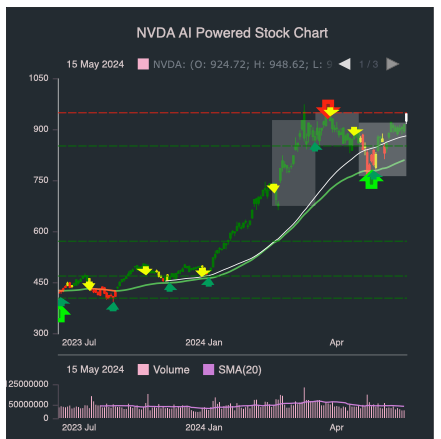20 Pro Tips For Deciding On AI Stock Analysis Sites
20 Pro Tips For Deciding On AI Stock Analysis Sites
Blog Article
Top 10 Suggestions On How To Assess The Strategy Customization Of Ai Trading Platforms
The capability to modify the trading platform according to your goals in trading as well as your tolerance for risk and market conditions are an important feature of AI-based stock prediction/analysis trading platforms. Platforms that offer powerful customization options will increase the efficiency of your trading. Here are 10 guidelines on how to assess the customization capabilities of platforms.
1. Evaluate Pre-Built Strategy Templates
Variety of templates: Check if the platform offers various pre-designed strategies that can be used for various trading styles (e.g. day trading, swing trading, long-term investment).
The user's experience is a good indication.
Performance history: Confirm that the platform contains historical data about performance for pre-built strategic plans.
2. Examine Customized Strategy Development
Drag-and-drop tools: Select platforms with drag-and-drop interfaces that permit you to quickly create personalized strategies.
Find out about coding options. For advanced users it is possible to determine if the platform allows custom programming.
Flexibility. Make sure you can define key components such as risk management parameters, entry/exit regulations, and any other elements that make up your strategy.
3. Check for Backtesting Capabilities
Historical data. Verify whether the platform is able to provide sufficient historical data in order to test the strategy.
Customizable settings: Be sure to have the ability to alter the parameters when backtesting.
Performance metrics: Ensure that the platform provides detailed metrics of performance (e.g. Win rate Sharpe Ratio, Drawdown) in the back-testing of strategies.
4. Evaluate Real-Time Strategy Testing
Paper trading Try out strategies in real time using paper trading or simulation.
Live testing - Check that you are able to test strategies using small amounts to see how they perform.
Real-time adjustments: Check to find out if your plan can be adjusted in real time according to the market conditions.
5. Assessment of Integration based on technical Indicators
Libraries of indicators: Ensure that the platform has a full library of technical tools (e.g. MACD, RSI and moving averages).
Custom indicators: Ensure that you can create or import custom indicators to use in your strategies.
Combination of indicators Examine whether the platform supports combining multiple indicators for more complex strategies.
6. Check for Risk Management Tools
Stop-loss/take-profit: Ensure the platform allows you to set stop-loss and take-profit levels within your strategies.
Position sizing. Make sure you have defined rules on the best way to handle your risk (e.g. an amount that is set or percentage of your portfolio).
Risk-reward ratio: Examine the platform's support for setting the risk/reward ratios of individual trades or trading strategies.
7. Evaluate Multi-Asset Strategy Support
Asset Classes: Check that the platform can support strategies from multiple asset types (e.g. ETFs, Options, Forex and Stocks).
Cross-assets strategies: Find out whether you're able to create strategies that incorporate different asset classes.
Market coverage: Ensure that the platform you are interested in covers the markets you are interested in (e.g. US or international cryptocurrencies, copyright).
8. Evaluate Automation and Execution
Automated trading: Ensure that the platform is able to automate the execution of strategies based on established rules.
Types of orders: Check whether your platform can handle different types of orders (e.g. market limit, limit, or stop) to carry out your the strategy.
Check for latency: Make sure that the platform is able to allow trades to be executed with the least amount of delay. This is crucial when it comes to high-frequency strategies.
9. Make sure you are using tools to optimize your strategy.
Optimization of parameters. Check that your platform permits you to optimize the parameters of your strategy (e.g. Grid search Genetic algorithms).
Machine learning: Ensure the platform you choose to use has machine learning that can be integrated to improve and optimise strategies.
Scenario analysis: Check if the platform allows you to try different strategies in different market scenarios (e.g. bear or bull, volatile).
10. Review User Feedback and Community Support
User reviews: Read the feedback of users to determine the platform's capacity to adapt strategies.
Community forums: Find out if there's an active community of users who are willing to share their strategies and ideas.
Support tools. Check for tutorials or webinars available to help you create and optimize your strategies.
Bonus Tips:
Trial period: Use the demo or trial version for free to try out the platform's and customization capabilities.
Scalability is important. The platform should be able to handle strategies that get more complicated when your trading expands.
Customer support Find out if support for your inquiries or concerns relating to the strategy.
With these suggestions, you will be able to evaluate the potential of AI platforms for analyzing and predicting stocks to tailor strategies. This will allow you to select a trading platform that matches your objectives in trading and permits you to develop and refine strategies. A platform that has robust customization features can enable you to adjust to changing market conditions and boost the efficiency of your trading. See the recommended helpful resource on AI stocks for website recommendations including ai investment app, chart ai trading assistant, ai for trading, ai trading, market ai, ai chart analysis, investment ai, stock ai, ai trade, stock ai and more.
Top 10 Tips To Assess The Risk Management Capabilities Of Ai Stock-Predicting/Analyzing Platforms
Risk management is an essential element of any AI trading platform that predicts or analyzes stocks, as it helps protect your investment and limit potential losses. Platforms that have robust risk management tools can help you navigate volatile stock markets and make the right decision. Below are the top ten suggestions to assess the risk management capabilities of these platforms.
1. Analysis of Stop-Loss and Take-Profit Features
Level that you can customize: You should be able customize the stop-loss/take-profit levels of specific strategies and trades.
Check the platform to see whether it has a trailing stop feature, which will adjust automatically when the market moves in your direction.
Find out if your platform permits you to place stop-loss orders which guarantee closing the trade at the amount stipulated, even on unstable markets.
2. Calculate Position Size Tools
Fixed amount: Make sure the platform allows you to define positions based on a certain amount of money that is fixed.
Percentage of Portfolio Determine whether it is feasible to define the size of your position as a percent of your portfolio total to control risk proportionally.
Risk-reward-ratio: Check if the platform permits users to determine their own risk/reward ratios.
3. Look for Diversification Aid
Multi-asset Trading: To diversify your portfolio of investments, make sure that the trading platform you select allows trading across multiple asset classes.
Sector allocation check to determine whether there are any tools available for managing and monitoring exposure to the sector.
Geographic diversification - Check that the platform allows the ability to trade on markets across the world. This will help reduce geographical risks.
4. Evaluation of Leverage and Margin controls
Margin requirements: Make sure the platform clearly outlines the margin requirements for leveraged trading.
Make sure your platform lets you set leverage limitations to limit the risk of exposure.
Margin call: Ensure whether the platform provides timely notification for margin calls. This could help avoid account closure.
5. Review Risk Analytics and Reporting
Risk metrics: Ensure the platform offers key risk indicators (e.g., Value at Risk (VaR) Sharpe ratio, drawdown) for your portfolio.
Scenario assessment: See if you can simulate different scenarios of markets on the platform in order to determine potential risks.
Performance reports: Find out whether the platform provides detailed performance reports that include the risk-adjusted return.
6. Check for Real-Time Risk Monitoring
Monitoring your portfolio: Make sure that the platform offers real-time monitoring of the risk exposure in your portfolio.
Notifications and alerts: Determine if the platform provides real-time alerts for risk-related events (e.g., margin breaches, Stop-loss triggers).
Risk dashboards: Make sure your platform offers customizable risk dashboards to give you a complete picture of your personal profile.
7. Assess the effects of stress testing and backtesting
Stress testing: Ensure that the platform lets you stress test your portfolio or strategies under extreme market conditions.
Backtesting: Determine if the platform supports backtesting strategies with historical data to assess the risk and effectiveness.
Monte Carlo: Verify the platform's use Monte Carlo-based simulations to evaluate risk and modeling a range or possible outcomes.
8. Risk Management Regulations: Assess compliance
Compliance with the regulatory requirements: Ensure that your platform is in compliance with the relevant regulations for risk management in Europe as well as the U.S. (e.g. MiFID II).
Best execution: Verify that the platform is in line with the best execution practices. The trades will be executed at the lowest price feasible to limit the chance of slippage.
Transparency Check the platform's transparency and the clarity of the disclosure of risks.
9. Check for user-controlled risk parameters
Custom Risk Rules: Make sure you have the ability to create custom rules for risk management (e.g. the maximum amount of daily loss, a certain size of tradable position).
Automated risk control: Ensure that the platform is able to enforce the risk management guidelines automatically, based on the pre-defined criteria.
Manual overrides: Verify that the platform supports manual overrides during emergency situations.
Review Case Studies and User Feedback
User reviews: Read user feedback to determine the effectiveness of the platform's risk management.
Case studies: Search for case studies or testimonials which highlight the platform's capabilities in the field of risk management.
Forums for community members Find out if there is a vibrant community of traders who share tips and strategies to manage risk.
Bonus Tips:
Trial period: Try a free trial or demo to test the features of the platform for risk management in real-world scenarios.
Support for customers: Ensure that the platform offers robust support regarding risk management related issues or questions.
Educational resources: Check whether the platform offers education resources or videos regarding risk management best practices.
These tips will help you determine the risk management capabilities of AI stock-predicting/analyzing trading platforms. This way you'll be able select a platform that protects your capital and limits potential losses. Effective risk management tools are vital to navigate the volatile markets and achieving long-term trading success. View the top breaking news on ai software stocks for site examples including best ai for stock trading, stock predictor, AI stock analysis, investing with ai, AI stock analysis, stock trading ai, free AI stock picker, AI stock analysis, ai options trading, how to use ai for copyright trading and more.